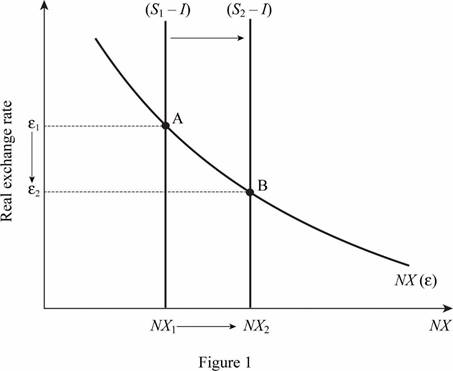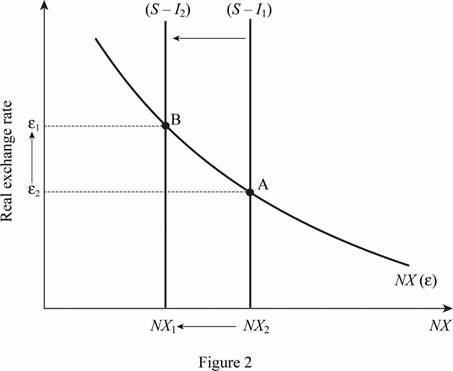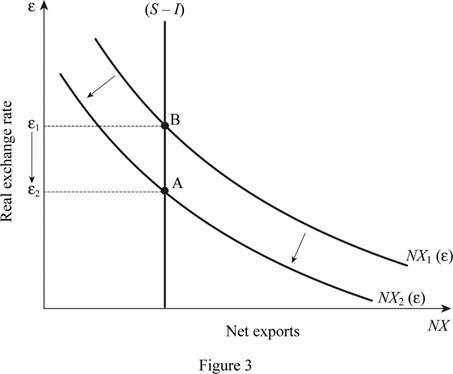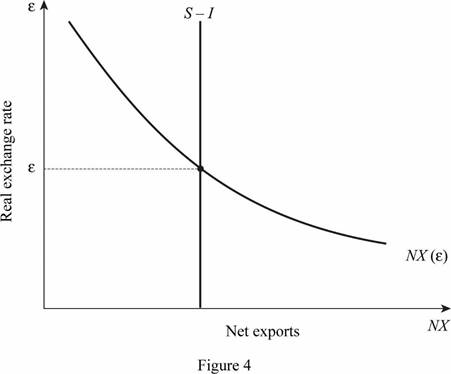
Subpart (a):
Changes in the trade balance, real exchange rate, and nominal exchange rate.
Subpart (a):
Explanation of Solution
The fall in consumer confidence about the future induces the following effect on the trade balance, real exchange rate, and the nominal exchange rate which is depicted in figure 1.

In figure 1, the horizontal axis measures the net exports (trade balance) and the vertical axis measures the real exchange rate.
When the consumer spends less and save more, the
Nominal exchange rate: Nominal exchange rate can be defined as the relative price of currencies of two countries that is the rate at which one currency can be exchanged for another currency.
Real exchange rate: Real exchange rate can be defined as the relative price of goods or services of two countries, which is the rate at which one can exchange the goods and services of one country for the goods and services of another.
Inflation: Inflation is the situation of abnormal price hike in the economy which leads to the situation of too much money chasing less number of goods.
Depreciation of currency: The depreciation of currency implies decrease in the value of currency of respective country.
Appreciation of currency: The appreciation of currency implies increase in the value of currency of that country.
Subpart (b):
The changes in the trade balance, real exchange rate and nominal exchange rate.
Subpart (b):
Explanation of Solution
The tax reform induces the following effect on trade balance, real exchange rate, and the nominal exchange rate which is depicted in figure 2.

In figure 2, the horizontal axis measures the net exports (trade balance) and the vertical axis measures the real exchange rate.
The tax reform induces business to build factories and this increase the investment, which shifts the
Nominal exchange rate: Nominal exchange rate can be defined as the relative price of currencies of two countries that is the rate at which one currency can be exchanged for another currency.
Real exchange rate: Real exchange rate can be defined as the relative price of goods or services of two countries, which is the rate at which one can exchange the goods and services of one country for the goods and services of another.
Inflation: Inflation is the situation of abnormal price hike in the economy which leads to the situation of too much money chasing les number of goods.
Depreciation of currency: The depreciation of currency implies decrease in the value of currency of respective country.
Appreciation of currency: The appreciation of currency implies increase in the value of currency of that country.
Subpart (c):
The changes in the trade balance, real exchange rate, and nominal exchange rate.
Subpart (c):
Explanation of Solution
The consumer prefers foreign cars over domestic cars induces the following effect on the trade balance, real exchange rate, and the nominal exchange rate which is depicted in figure 3.

In figure 3, the horizontal axis measures the net exports (trade balance) and the vertical axis measures the real exchange rate.
The consumers’ preference for foreign cars over the domestic cars would have no effect on the savings and investment and therefore, there is no shift in
Nominal exchange rate: Nominal exchange rate can be defined as the relative price of currencies of two countries that is the rate at which one currency can be exchanged for another currency.
Real exchange rate: Real exchange rate can be defined as the relative price of goods or services of two countries, which is the rate at which one can exchange the goods and services of one country for the goods and services of another.
Inflation: Inflation is the situation of abnormal price hike in the economy which leads to the situation of too much money chasing less number of goods.
Depreciation of currency: The depreciation of currency implies decrease in the value of currency of respective country.
Appreciation of currency: The appreciation of currency implies increase in the value of currency of that country.
Subpart (d):
The changes in the trade balance, real exchange rate, and nominal exchange rate.
Subpart (d):
Explanation of Solution
Doubling the money supply induces the following effect on trade balance, real exchange rate, and the nominal exchange rate which is depicted in figure 4.

In figure 4, the horizontal axis measures the net exports (trade balance) and the vertical axis measures the real exchange rate.
Output Y is determined by the amount of capital and labor, whereas the investment I(r*) is determined by the world interest rate (r*). The net export (NX), on the other hand, is determined by the difference in domestic saving and domestic investment
Doubling the money supply has no effect on any real variables by the money neutrality. However, it affects the nominal exchange rate through its effect on the domestic price level P.
Price level P adjusts to equilibrate the
The level of output and the interest rate determines the real money demand
The nominal exchange rate is given as follows:
It can be expressed as follows:
Where e is the nominal exchange rate,
Nominal exchange rate: Nominal exchange rate can be defined as the relative price of currencies of two countries that is the rate at which one currency can be exchanged for another currency.
Real exchange rate: Real exchange rate can be defined as the relative price of goods or services of two countries, which is the rate at which one can exchange the goods and services of one country for the goods and services of another.
Depreciation of currency: The depreciation of currency implies decrease in the value of currency of respective country.
Appreciation of currency: The appreciation of currency implies increase in the value of currency of that country.
Subpart (e):
The changes in the trade balance, real exchange rate and nominal exchange rate.
Subpart (e):
Explanation of Solution
Increase in the demand for money induces the following effect on trade balance, real exchange rate, and the nominal exchange rate.
Output Y is determined by the amount of capital and labor, whereas investment I(r*) is determined by the world interest rate (r*). The net export (NX), on the other hand, is determined by difference in domestic saving and domestic investment
The increase in demand for money has no effect on any real variables by the money neutrality. However, it affects the nominal exchange rate through its effect on the domestic price level P.
Price level P adjusts to equilibrate the demand for supply of real balances which is given as follows:
The level of output and the interest rate determines the real money demand
The nominal exchange rate is given as follows:
It can be expressed as follows:
Here, e is the nominal exchange rate,
Nominal exchange rate: Nominal exchange rate can be defined as the relative price of currencies of two countries that is the rate at which one currency can be exchanged for another currency.
Real exchange rate: Real exchange rate can be defined as the relative price of goods or services of two countries, which is the rate at which one can exchange the goods and services of one country for the goods and services of another.
Depreciation of currency: The depreciation of currency implies decrease in the value of currency of respective country.
Appreciation of currency: The appreciation of currency implies increase in the value of currency of that country.
Want to see more full solutions like this?
Chapter 6 Solutions
Macroeconomics (Cloth) (Instructor's)
- Evaluate the effectiveness of supply and demand models in predicting labor market outcomes. Justify your assessment with specific examples from real-world labor markets.arrow_forwardExplain the difference between Microeconomics and Macroeconomics? 2.) Explain what fiscal policy is and then explain what Monetary Policy is? 3.) Why is opportunity cost and give one example from your own of opportunity cost. 4.) What are models and what model did we already discuss in class? 5.) What is meant by scarcity of resources?arrow_forward2. What is the payoff from a long futures position where you are obligated to buy at the contract price? What is the payoff from a short futures position where you are obligated to sell at the contract price?? Draw the payoff diagram for each position. Payoff from Futures Contract F=$50.85 S1 Long $100 $95 $90 $85 $80 $75 $70 $65 $60 $55 $50.85 $50 $45 $40 $35 $30 $25 Shortarrow_forward
- 3. Consider a call on the same underlier (Cisco). The strike is $50.85, which is the forward price. The owner of the call has the choice or option to buy at the strike. They get to see the market price S1 before they decide. We assume they are rational. What is the payoff from owning (also known as being long) the call? What is the payoff from selling (also known as being short) the call? Payoff from Call with Strike of k=$50.85 S1 Long $100 $95 $90 $85 $80 $75 $70 $65 $60 $55 $50.85 $50 $45 $40 $35 $30 $25 Shortarrow_forward4. Consider a put on the same underlier (Cisco). The strike is $50.85, which is the forward price. The owner of the call has the choice or option to buy at the strike. They get to see the market price S1 before they decide. We assume they are rational. What is the payoff from owning (also known as being long) the put? What is the payoff from selling (also known as being short) the put? Payoff from Put with Strike of k=$50.85 S1 Long $100 $95 $90 $85 $80 $75 $70 $65 $60 $55 $50.85 $50 $45 $40 $35 $30 $25 Shortarrow_forwardThe following table provides information on two technology companies, IBM and Cisco. Use the data to answer the following questions. Company IBM Cisco Systems Stock Price Dividend (trailing 12 months) $150.00 $50.00 $7.00 Dividend (next 12 months) $7.35 Dividend Growth 5.0% $2.00 $2.15 7.5% 1. You buy a futures contract instead of purchasing Cisco stock at $50. What is the one-year futures price, assuming the risk-free interest rate is 6%? Remember to adjust the futures price for the dividend of $2.15.arrow_forward
- 5. Consider a one-year European-style call option on Cisco stock. The strike is $50.85, which is the forward price. The risk-free interest rate is 6%. Assume the stock price either doubles or halves each period. The price movement corresponds to u = 2 and d = ½ = 1/u. S1 = $100 Call payoff= SO = $50 S1 = $25 Call payoff= What is the call payoff for $1 = $100? What is the call payoff for S1 = $25?arrow_forwardMC The diagram shows a pharmaceutical firm's demand curve and marginal cost curve for a new heart medication for which the firm holds a 20-year patent on its production. Assume this pharmaceutical firm charges a single price for its drug. At its profit-maximizing level of output, it will generate a total profit represented by OA. areas J+K. B. areas F+I+H+G+J+K OC. areas E+F+I+H+G. D. - it is not possible to determine with the informatio OE. the sum of areas A through K. (...) Po P1 Price F P2 E H 0 G B Q MR D ōarrow_forwardPrice Quantity $26 0 The marketing department of $24 20,000 Johnny Rockabilly's record company $22 40,000 has determined that the demand for his $20 60,000 latest CD is given in the table at right. $18 80,000 $16 100,000 $14 120,000 The record company's costs consist of a $240,000 fixed cost of recording the CD, an $8 per CD variable cost of producing and distributing the CD, plus the cost of paying Johnny for his creative talent. The company is considering two plans for paying Johnny. Plan 1: Johnny receives a zero fixed recording fee and a $4 per CD royalty for each CD that is sold. Plan 2: Johnny receives a $400,000 fixed recording fee and zero royalty per CD sold. Under either plan, the record company will choose the price of Johnny's CD so as to maximize its (the record company's) profit. The record company's profit is the revenues minus costs, where the costs include the costs of production, distribution, and the payment made to Johnny. Johnny's payment will be be under plan 2 as…arrow_forward
- Which of the following is the best example of perfect price discrimination? A. Universities give entry scholarships to poorer students. B. Students pay lower prices at the local theatre. ○ C. A hotel charges for its rooms according to the number of days left before the check-in date. ○ D. People who collect the mail coupons get discounts at the local food store. ○ E. An airline offers a discount to students.arrow_forwardConsider the figure at the right. The profit of the single-price monopolist OA. is shown by area D+H+I+F+A. B. is shown by area A+I+F. OC. is shown by area D + H. ○ D. is zero. ○ E. cannot be calculated or shown with just the information given in the graph. (C) Price ($) B C D H FIG шо E MC ATC A MR D = AR Quantityarrow_forwardConsider the figure. A perfectly price-discriminating monopolist will produce ○ A. 162 units and charge a price equal to $69. ○ B. 356 units and charge a price equal to $52 for the last unit sold only. OC. 162 units and charge a price equal to $52. OD. 356 units and charge a price equal to the perfectly competitive price. Dollars per Unit $69 $52 MR 162 356 Output MC Darrow_forward
 Brief Principles of Macroeconomics (MindTap Cours...EconomicsISBN:9781337091985Author:N. Gregory MankiwPublisher:Cengage Learning
Brief Principles of Macroeconomics (MindTap Cours...EconomicsISBN:9781337091985Author:N. Gregory MankiwPublisher:Cengage Learning
 Macroeconomics: Private and Public Choice (MindTa...EconomicsISBN:9781305506756Author:James D. Gwartney, Richard L. Stroup, Russell S. Sobel, David A. MacphersonPublisher:Cengage Learning
Macroeconomics: Private and Public Choice (MindTa...EconomicsISBN:9781305506756Author:James D. Gwartney, Richard L. Stroup, Russell S. Sobel, David A. MacphersonPublisher:Cengage Learning Economics: Private and Public Choice (MindTap Cou...EconomicsISBN:9781305506725Author:James D. Gwartney, Richard L. Stroup, Russell S. Sobel, David A. MacphersonPublisher:Cengage Learning
Economics: Private and Public Choice (MindTap Cou...EconomicsISBN:9781305506725Author:James D. Gwartney, Richard L. Stroup, Russell S. Sobel, David A. MacphersonPublisher:Cengage Learning Economics (MindTap Course List)EconomicsISBN:9781337617383Author:Roger A. ArnoldPublisher:Cengage Learning
Economics (MindTap Course List)EconomicsISBN:9781337617383Author:Roger A. ArnoldPublisher:Cengage Learning





